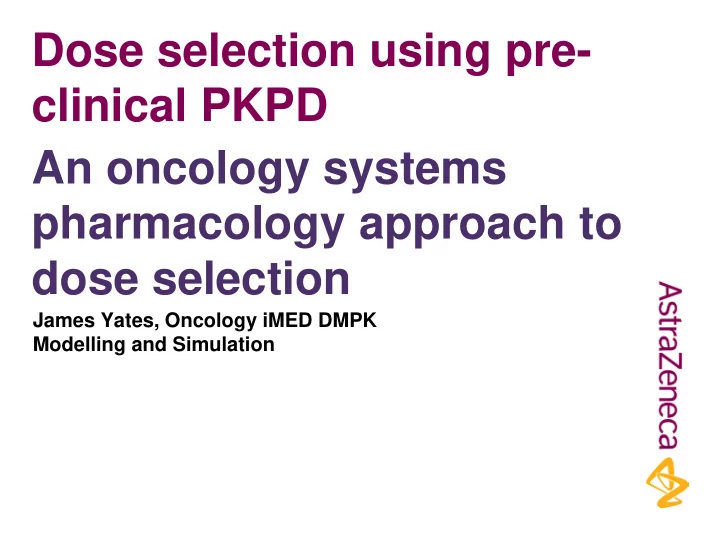

Dose selection using pre- clinical PKPD An oncology systems pharmacology approach to dose selection James Yates, Oncology iMED DMPK Modelling and Simulation
Disclaimer The views and opinions expressed in these slides are mine and do not necessarily represent the views of AstraZeneca D-E-R Workshop 2014
Problem statement Early clinical trial data – what dose to take forward? AZD9291: EGFR inhibitor At the time this modelling was carried out: 1. Doses 20-160mg QD investigated 2. Responses observed at all doses 3. MTD not identified 4. Did not want to take MTD forward – take biologically effective dose forward with good safety profile 5. What is this dose? (Part) of the solution: A mathematical model relating PK, PD and efficacy had been developed during the discovery program. Use this to put differences between mouse and human PK into context and simulate clinical dose response Will discuss pre-clinical model development and application to make clinical dose decision D-E-R Workshop 2014
Mouse PK Simultaneous modelling of active parent and metabolite Parent – Green Metabolite - Maroon D-E-R Workshop 2014
Linking PK to pEGFR PD Turnover model with irreversible binding combining parent and metabolite drug effect Ratio of parent to metabolite potency fixed to in vitro value Model and data D-E-R Workshop 2014
pEGFR knock down – PKPD hysteresis plot PK does not determine duration of effect D-E-R Workshop 2014
PD Model to explain efficacy Determining the relationship between pEGFR reduction and efficacy pEGFR reduction linked to cell death within mathematical model of tumour growth Result is linkage between target engagement and efficacy D-E-R Workshop 2014
Human Half-life is much longer than mouse. How does this impact PKPD? Simulate dose fractionation in mouse More frequent dosing gives lower Cmax – 4 fold difference between QD and 10D More frequent dosing gives higher Cmin D-E-R Workshop 2014
Simulated Mouse Efficacy for dose fractionation Dose response changes with dosing frequency 450 Efficacy increases with total dose, but ... 400 350 Increasing dosing frequency 300 250 QD %TGI ... lower daily dose (AUC) as %TGI effective as higher dose if BD 200 given more frequently than TID QD 150 10D 100 50 0 0 5 10 15 20 25 30 Total daily dose mg/kg Total daily dose mg/kg Simulated dose fractionation suggested that frequency of delivery was not critical. If anything the flatter profile resulting from frequent dosing was most effective according to the model. This is encouraging given long half-life in D-E-R Workshop 2014 human
Capturing clinical PK variability Varying CL captures a large amount of variability. 0.8 0.045 0.6 0.04 0.035 0.4 0.03 AZD9291 uM AZ5104 uM 0.025 0.2 0.02 0.015 0 0.01 0 50 100 150 200 0.005 -0.2 0 0 50 100 150 200 -0.4 Time hrs Time hrs AZD9291 Simulation 97.5% Simulation 2.5% AZ5104 Simulation 97.5% Simulation 2.5% Not a formal pop PK analysis – used model of predicted human PK and updated based upon observed data Lower end of exposure captured – important for biologically effective dose questions D-E-R Workshop 2014
AZD9291 clinical dose response simulation Human PK combined with mouse PD-efficacy 1 st generation TKI resistant Activating mutant Wild type xenograft Modelling suggests dose response against mutant EGFR saturates by 80mg Observed Safety profile good at this dose D-E-R Workshop 2014
Conclusions Use of pre-clinical modelling to guide clinical dosing 1. Integration of clinical PK with pre-clinical PD-efficacy relationship has provided a way to augment early clinical data with richer pre-clinical data set. 2. Allows the biologically effective dose (based upon animal models and clinical exposure) to be identified. 3. Potential to remove necessity to dose to MTD to maximise probability of clinical activity. 4. Ongoing question of quantitative translation of animal models of cancers to the clinic D-E-R Workshop 2014
Confidentiality Notice This file is private and may contain confidential and proprietary information. If you have received this file in error, please notify us and remove it from your system and note that you must not copy, distribute or take any action in reliance on it. Any unauthorized use or disclosure of the contents of this file is not permitted and may be unlawful. AstraZeneca PLC, 2 Kingdom Street, London, W2 6BD, UK, T: +44(0)20 7604 8000, F: +44 (0)20 7604 8151, www.astrazeneca.com D-E-R Workshop 2014
Recommend
More recommend